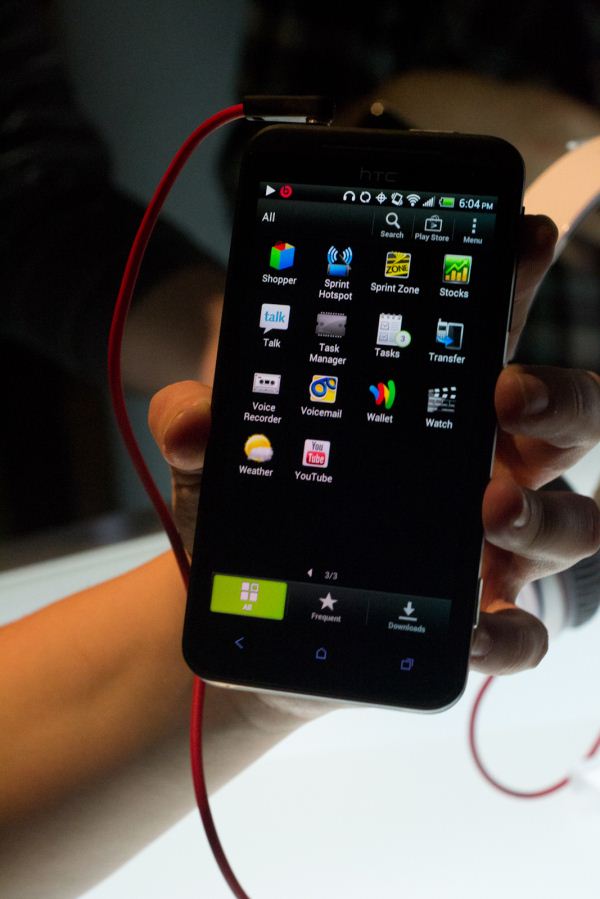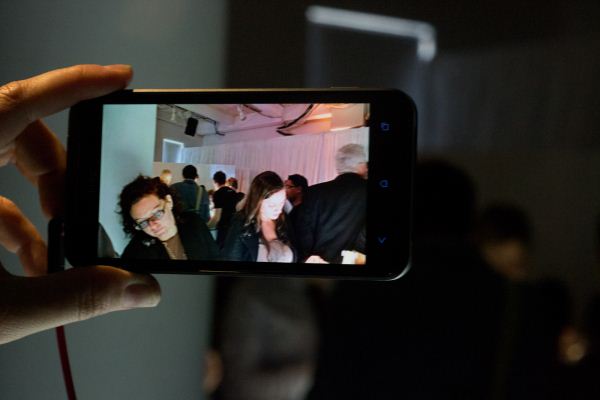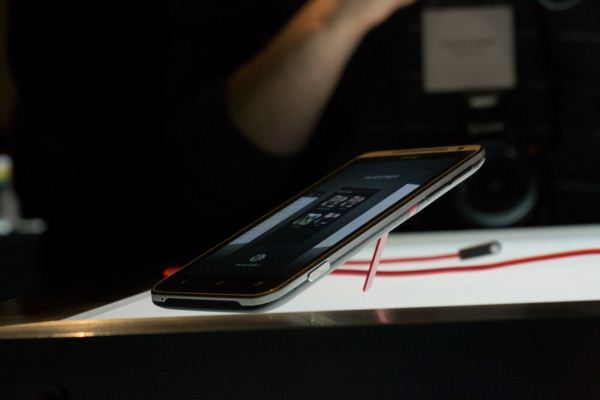HTC And Sprint Announce The EVO 4G LTE: Krait and LTE, on Sprint for $199 [Updated w/ Hands-on]
by Jason Inofuentes on April 4, 2012 5:29 PM EST- Posted in
- Laptops
- Snapdragon
- HTC
- Sprint
- Qualcomm
- LTE
- Smartphones
- Krait
- Mobile
- EVO 4G LTE
During the remarks HTC brought on Jonah Becker to discuss the design initiatives that went into creating this latest EVO device. Notably, the phone's chassis is anodized and chemically etched to create a black soft-touch surface. The edge of the phone is shaved to give it that silver rim, and the red-accent bits are also anodized aluminum. The matte finish over much of the phone is interrupted by the glossy upper portion of the back, which is a removable glossy black cover that provides access to the microSD card slot. The battery is inaccessible, a necessity in designing a phone this thin that doesn't use an AMOLED display.
In the hand the phone feels light, and comfortable, though the soft surfaces give me the fear I'm going to drop it any second. The size of the device doesn't feel overwhelming, a fact that's helped by the narrow bezels on the sides of the screen. The screen looks fantastic, and viewing angles are good at 160 degrees, though there was some color distortion at those extremes. I am still surprised to see capacitive buttons on ICS devices, though I suspect they will remain featured on lots of devices, long after this one. The dedicated shutter is an aluminum piece that feels solid and easy to actuate without rocking the device. The volume rocker is a little less compelling as it matches the glossy rear cover and feels a little squishy.
The software feels snappy and responsive; HTC's Sense 4.0 is still the Sense we know and love/hate, but apparently less intrusive. I say apparently because the hallmarks of Sense are all still there. The prominent clock and weather widget is updated with the Roboto font. The dock still retains four customizable apps along with the app drawer. The lock screen still features a ring that can be used to unlock the phone or activate one of four customizable apps. Indeed, there are few areas that seem to be untouched. Even the app switcher has been rejiggered with a WebOS-like card interface, set as a 3D carousel. So, this isn't vanilla Android, but it doesn't seem to be slowing the device down.
As we mentioned in the overview, the camera received special attention, both here and on the entire One line. HTC's ImageSense branding represents the f/2.0 lens and the imaging ISP they've included. With all that, HTC has once again put their mark on the camera interface, including a continuous shot mode (4 stills per second, up to 90 seconds) and is activated by simply holding the shutter down. An HDR mode is included along with the typical panorama and scene modes. The 8MP pixel sensor is capable of shooting 1080P video, and in this implementation is actually taking near continuous 5MP stills so still shots can still be taken while shooting video. In practice, the images look good, when we get a device in for review we will be excited to dig deeper and see just what magic HTC has dug up for their imaging ISP.
A long line formed in front of a pair of sound proof booths that HTC and Sprint set-up to demonstrate their HD Voice implementation. As Brian mentioned, the use of EVRC-NW will greatly improve the frequency response of Sprint's voice calls, though still falls short of providing the full range of the human voice. We can expect more of these sorts of announcements from all the major US carriers in the near future, making our analysis of noise cancelation and voice quality all the more pertinent. Improved vocoders help not at all if what's transmitted is still noisy and garbled.
And then there's the kickstand. I've been a fan of the idea on consumer electronics devices since the first time I saw someone trying to watch a video on a 5th generation iPod. The particular design used on this EVO is a little stiff to deploy, but once out can be positioned in two different landscape angles, and in portrait. Portrait seems handy for video chat, and the two different landscape position can be useful when on flights with an awkwardly positioned tray table. The kickstand itself feels incredibly solid and would likely require a good bit of force to break.
All told, during our short time with the device, it felt good in the hand, and as smooth as we'd expect a Krait device to feel. Now comes the waiting game. Pre-orders start on 5/7, painting a picture that puts this phone available late in the second quarter of 2012. Enjoy the gallery and feel free to send any questions our way.














22 Comments
View All Comments
Impulses - Thursday, April 5, 2012 - link
Why? SLCD isn't inherently inferior in any form except for black levels... And most subjective opinions seem to indicate this display is better than the Galaxy Nexus' own. I'll reserve final judgement until Anandtech's in-depth analysis, but I don't expect the screen to be disappointing in any way. Samsung tends to ship their AMOLED equipped phones with terribly uncalibrated colors anyway...Frankly, the new EVO's specs make it sound like a near perfect device... Only way it could be any better is if it was a world phone and the battery was removable, but it has a bunch of improvements over the One X while retaining the same dimensions. MicroSD, kickstand, covers button, larger battery... I'm very surprised all that + LTE didn't lead to a chunkier phone (guess we have Krait to thank for that).
Going with a mix of plastic and aluminum construction probably left just a bit more internal room than the One X's polycarb unibody (which I assume is thicker than aluminum).
Impulses - Thursday, April 5, 2012 - link
Meant camera button, not covers button... I'm surprised that didn't get more press btw... I believe I read on an Engadget article that it even lets you bring up the camera while the phone is locked, much like WP7 devices (and unlike the EVO 3D and it's much advertised dual stage camera button).Have any Android phones ever had a camera button with that ability? I guess it's less noteworthy now that even stock ICS has a lockscreen camera shortcut, but it still seems really neat.
Beerfloat - Thursday, April 5, 2012 - link
..not that bad, really :)For all of amoled's positive press, I bet 8 out of 10 unprejudiced viewers will pick the substantially brighter, more colorful SLCD screens, even against non-pentile amoled (which aren't available in HD res yet).
Reikon - Thursday, April 5, 2012 - link
No AMOLED is :)All the ones I've seen are oversaturated and have too high of a color temperature, i.e. too blue. Less hassle of making everything dark to conserve battery too.
piroroadkill - Thursday, April 5, 2012 - link
Stop making so many phones. Jesus christ. Put the docking connector on this, the EVO 4G LTE, and get rid of the One X. This is better, as it is has: microSD port, larger battery, Krait, and even a kickstand.ggg777 - Thursday, April 5, 2012 - link
Will this phone or others powered by the S4 chip be compatible with Canadian LTE networks? The Rezound was a Verizon only phone, yet it is now known to work on every network, same idea with the Amaze 4G, does this next generation of SoC also include capabilities not openly advertised?fteoath64 - Thursday, April 5, 2012 - link
The only LTE network it probably does not like is the Australian LTE. The Krait is going to be the king of cellphone chips for 2012 until possibly the end of 2013. It seems to be sipping very little power due to its power management cores in the chip. A sure winner for smartphones and tablets alike. I would like to see it scale to 2.6Ghz.NeoteriX - Thursday, April 5, 2012 - link
So is the camera button single stage or dual stage?Impulses - Thursday, April 5, 2012 - link
Dual according to engadget.s1175290 - Thursday, April 5, 2012 - link
They had me until:"The battery is inaccessible"
I'm all for slim phones, but I can't ever imagine buying one where I can't replace the battery. I would gladly trade a slightly thicker phone for the ability to change/replace the battery.